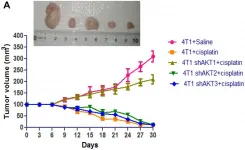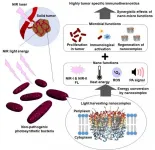(Press-News.org) TAMPA, Fla. - One of the most challenging issues in cancer therapy is the development of drug resistance and subsequent disease progression. In a new article featured on this month's cover of Cancer Research, Moffitt Cancer Center researchers, in collaboration with Oxford University, report results from their study using mathematical modeling to show that cell turnover impacts drug resistance and is an important factor that governs the success of adaptive therapy.
Cancer treatment options have increased substantially over the past few decades; however, many patients eventually develop drug resistance. Physicians strive to overcome resistance by either trying to target cancer cells through an alternative approach or targeting the resistance mechanism itself, but success with these approaches is often limited, as additional resistance mechanisms can arise.
Researchers in Moffitt's Integrated Mathematical Oncology Department and Center of Excellence for Evolutionary Therapy believe that resistance may partly develop because of the high doses of drugs that are commonly used during treatment. Patients are typically administered a maximum tolerated dose of therapy that kills as many cancer cells as possible with the fewest side effects. However, according to evolutionary theories, this maximum tolerated dose approach could lead to drug resistance because of the existence of drug resistant cells before treatment even begins. Once sensitive cells are killed by anti-cancer therapies, these drug resistant cells are given free rein to divide and multiply. Moffitt researchers believe an alternative treatment strategy called adaptive therapy may be a better approach to kill cancer cells and minimize the development of drug resistance.
"Adaptive therapy aims not to eradicate the tumor, but to control it. Therapy is applied to reduce tumor burden to a tolerable level but is subsequently modulated or withdrawn to maintain a pool of drug-sensitive cancer cells," said Alexander Anderson, Ph.D., chair of the Integrated Mathematical Oncology Department and founding director of the Center of Excellence for Evolutionary Therapy.
Previous laboratory studies have shown that adaptive therapy can prolong the time to cancer progression for several different tumor types, including ovarian, breast and melanoma. Additionally, a clinical trial in prostate cancer patients at Moffitt has shown that compared to standard treatment, adaptive therapy increased the time to cancer progression by approximately 10 months and reduced the cumulative drug usage by 53%.
Despite these encouraging results, it is unclear which tumor types will respond best to adaptive therapy in the clinic. Recent studies have shown that the success of adaptive therapy is dependent on different factors, including levels of spatial constraint, the fitness of the resistant cell population, the initial number of resistant cells and the mechanisms of resistance. However, it is unclear how the cost of resistance factors into a tumor's response to adaptive therapy.
The cost of resistance refers to the idea that cells that become resistant have a fitness advantage over non-resistant cells when a drug is present, but this may come at a cost, such as a slower growth rate. However, drug resistance is not always associated with a cost and it is unclear whether a cost of resistance is necessary for the success of adaptive therapy.
The research team at Moffitt used mathematical modeling to determine how the cost of resistance is associated with adaptive therapy. They modeled the growth of drug sensitive and resistant cell populations under both continuous therapy and adaptive therapy conditions and compared their time to disease progression in the presence and absence of a cost of resistance.
The researchers showed that tumors with higher cell density and those with smaller levels of pre-existing resistance did better under adaptive therapy conditions. They also showed that cell turnover is a key factor that impacts the cost of resistance and outcomes to adaptive therapy by increasing competition between sensitive and resistance cells. To do so, they made use of phase plane techniques, which provide a visual way to dissect the dynamics of mathematical models.
"I'm a very visual person and find that phase planes make it easy to gain an intuition for a model. You don't need to manipulate equations, which makes them great for communicating with experimental and clinical collaborators. We are honored that Cancer Research selected our collage of phase planes for their cover and hope this will help making mathematical oncology accessible to more people," said Maximilian Strobl, lead study author and doctoral candidate at University of Oxford.
To confirm their models, the researchers analyzed data from 67 prostate cancer patients undergoing intermittent therapy treatment, a predecessor of adaptive therapy.
"We find that even though our model was constructed as a conceptual tool, it can recapitulate individual patient dynamics for a majority of patients, and that it can describe patients who continuously respond, as well as those who eventually relapse," said Anderson.
While more studies are needed to understand how adaptive therapies may benefit patients, researchers are hopeful their data will lead to better indicators of which tumors will respond to adaptive therapy.
"With better understanding of tumor growth, resistance costs, and turnover rates, adaptive therapy can be more carefully tailored to patients who stand to benefit from it the most and, more importantly, highlight which patients may benefit from multi-drug approaches," said Anderson.
INFORMATION:
Their work was supported by funding from the Engineering and Physical Sciences Research Council, the Medical Research Council, the National Institutes of Health and the Moffitt Center of Excellence for Evolutionary Therapy.
About Moffitt Cancer Center
Moffitt is dedicated to one lifesaving mission: to contribute to the prevention and cure of cancer. The Tampa-based facility is one of only 51 National Cancer Institute-designated Comprehensive Cancer Centers, a distinction that recognizes Moffitt's scientific excellence, multidisciplinary research, and robust training and education. Moffitt is the No. 11 cancer hospital and has been nationally ranked by U.S. News & World Report since 1999. Moffitt's expert nursing staff is recognized by the American Nurses Credentialing Center with Magnet® status, its highest distinction. With more than 7,000 team members, Moffitt has an economic impact in the state of $2.4 billion. For more information, call 1-888-MOFFITT (1-888-663-3488), visit MOFFITT.org, and follow the momentum on Facebook, Twitter, Instagram and YouTube.
Oncotarget recently published "Targeting an engineered cytokine with interleukin-2 and interleukin-15 activity to the neovasculature of solid tumors" by Mortensen, et al. which reported that there is a growing interest in the antibody-based delivery of cytokines to the tumor environment as a means to boost the anti-cancer activity of tumor-resident T cells and NK cells.
Here, the authors described the expression and characterization of fusion proteins, featuring the L19 antibody and an engineered cytokine with interleukin-2 and interleukin-15 ...
Oncotarget recently published "AKT isoforms have discrete expression in triple negative breast cancers and roles in cisplatin sensitivity" which reported that the authors investigated the expression and net effect of the individual isoforms in triple negative breast cancers and response to cisplatin treatment using cellular, mice models and clinical samples.
Interestingly, analysis of the expressions of AKT isoforms in clinical samples showed relatively higher expression of AKT1 in primary tissues; whereas lung and liver metastatic samples showed elevated ...
Coffee, cola or an energy drink: caffeine is the world's most widely consumed psychoactive substance. Researchers from the University of Basel have now shown in a study that regular caffeine intake can change the gray matter of the brain. However, the effect appears to be temporary.
No question - caffeine helps most of us to feel more alert. However, it can disrupt our sleep if consumed in the evening. Sleep deprivation can in turn affect the gray matter of the brain, as previous studies have shown. So can regular caffeine consumption affect brain structure due to poor sleep? A research team led by Dr. Carolin Reichert and Professor Christian Cajochen of the University of Basel ...
Here is a link to watch a video interview with Dr. Beatrice Aramini about this topic on the Oncotarget YouTube Channel
Oncotarget published "Cancer stem cells and macrophages: molecular connections and future perspectives against cancer" which reported that Cancer stem cells have been considered the key drivers of cancer initiation and progression due to their unlimited self-renewal capacity and their ability to induce tumor formation.
Macrophages, particularly tumor-associated macrophages, establish a tumor microenvironment to protect and induce CSCs development and dissemination.
Many studies in the past decade have been performed to understand the molecular ...
For the first time, physicists from the University of Basel have produced a graphene compound consisting of carbon atoms and a small number of nitrogen atoms in a regular grid of hexagons and triangles. This honeycomb-structured "kagome lattice" behaves as a semiconductor and may also have unusual electrical properties. In the future, it could potentially be used in electronic sensors or quantum computers.
Researchers around the world are searching for new synthetic materials with special properties such as superconductivity -- that is, the conduction of electric current without resistance. These new substances are an important step in the development ...
Climate change is rapid in the Arctic. As the climate warms, shrubs expand towards higher latitudes and altitudes. Researcher Julia Kemppinen together with her colleagues investigated the impacts of dwarf shrubs on tundra soils in the sub-Arctic Fennoscandia.
The study revealed that the dominance of dwarf shrubs impacts soil microclimate and carbon stocks. Microclimate describes the moisture and temperature conditions close to ground surface. Shrubs are the largest plant life form in the Arctic, and in comparison, to other arctic plants, shrubs use more water and cast more shade.
"The results indicate ...
WASHINGTON -- When people pause before replying to a question, even for just a few seconds, their answers are perceived to be less sincere and credible than if they had replied immediately, according to research published by the American Psychological Association.
And the longer the hesitation, the less sincere the response appears.
"Evaluating other people's sincerity is a ubiquitous and important part of social interactions," said lead author Ignazio Ziano, PhD, of Grenoble Ecole de Management. "Our research shows that response speed is an important cue on which people base their sincerity inferences."
The research was published in the Journal of Personality and Social Psychology.
Researchers ...
Cancer is one of the most thought-provoking healthcare problems throughout the world. The development of therapeutic agents with highly selective anti-cancer activities is increasingly attractive due to the lack of tumor selectivity of conventional treatments.
Scientists at Japan Advanced Institute of Science and Technology (JAIST) have created a photosynthetic bacteria-based cancer optotheranostics (Figure 1).
Discovered by Associate Professor Eijiro Miyako and his team from JAIST, natural purple photosynthetic bacteria (PPSB) can play a key role as a highly active cancer immunotheranostics agent that uses the bio-optical-window I and II near-infrared (NIR) light thanks to the light harvesting nanocomplexes in microbial ...
There is no coat colour that distinguishes dingoes from dingo-dog hybrids, a study involving UNSW Sydney has found.
The Centre for Ecosystem Science research suggests that animals assumed to be dingo-dog hybrids based on their coat colour and culled may have been pure dingoes.
"We actually found pure dingoes that had a brindle, black and tan, patchy or sable coat colour," Dr Kylie Cairns, a conservation biologist from UNSW Sydney and co-author of the study said.
"So that's showing that really dingoes are much more variable than we think and seeing an animal with an odd coat colour doesn't immediately mean that it's a hybrid.
"Using coat colour to decide what animals should be culled is not a very good idea."
The study follows 2019 research by UNSW and collaborators which found ...
San Antonio, Texas (February 15, 2020) - Researchers at the Southwest National Primate Research Center (SNPRC) at Texas Biomedical Research Institute (Texas Biomed) may have found a new pathway to treat and control tuberculosis (TB), the disease caused by Mycobacterium tuberculosis (Mtb). Using single-cell RNA sequencing (scRNAseq), a next-generation sequencing technology, scientists were able to further define the mechanisms that lead to TB infection and latency. Co-led by Deepak Kaushal, Ph.D., Director of the SNPRC, this is the first study that used scRNAseq to study TB in macaques in depth. Results from the study were published ...




